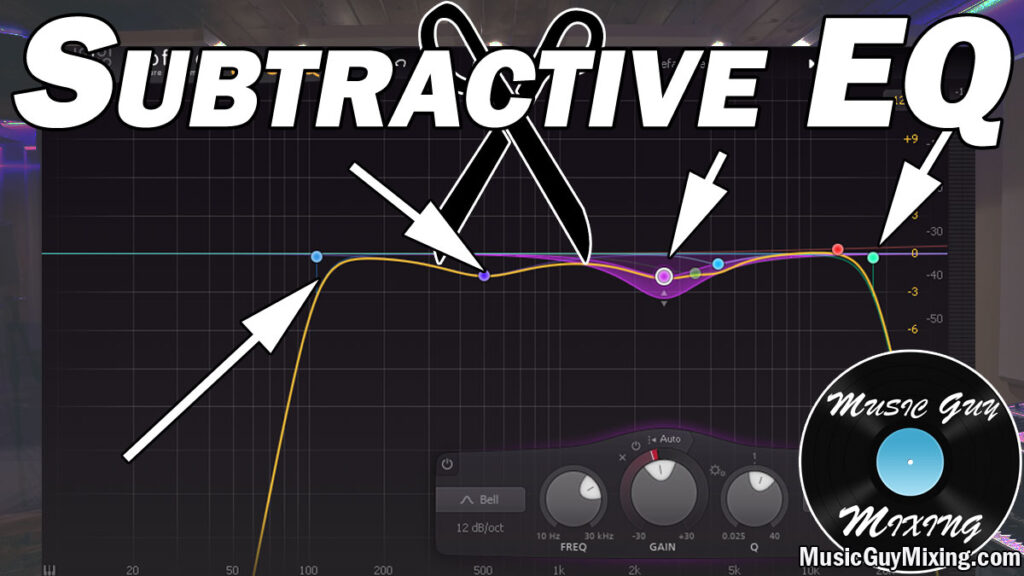There are two different types of EQ: additive and subtractive EQ. Nevermind that one sounds like an artificial sweetener, we’re going to focus on subtractive EQ and talk about what it is and why it’s the preferred method of EQ in mixing.
What is Subtractive EQ
With an EQ plugin you have two options: add or remove from the frequencies which make up your audio.

You maybe have heard this phrase before: addition by subtraction. You make something better by taking something else away.
This is the theory behind subtractive EQ; subtractive EQ is the process of focusing on cutting rather than boosting frequencies.
In theory, subtractive EQ is preferred because removing everything you DON’T want from your audio track just leaves in the good stuff.
You generally want to do this on every track in your mix before you do any other processing.
The idea is cut out what you don’t need, then you’re left with the rest/everything you DO want to be processed next in the chain.
This keeps any frequency information we don’t want from being potentially brought up when we move on to compression.
A prime example is high pass filtering. Virtually every track in your mix that’s not a virtual instrument will have some kind of low end noise that we don’t want.
It clutters up our mix whether we can hear it or not, especially when you add it up over dozens of tracks. Mute your bass and kick in your mix and solo everything below 100Hz. If you haven’t done any high pass filtering, you’ll hear what I’m talking about.
We want to roll this off for each instrument individually via subtractive EQ (grab my complete EQ cheat sheet to show you how to EQ every frequency of every instrument in your mix) before we move on any other processing.
Doing this with no other subtractive EQ can make a huge difference alone in cleaning up the low end and removing mud from our mix.
Let’s also keep in mind that anytime we subtract from one frequency range, we’re placing a greater emphasis on what we leave behind.
This is another principle of subtractive EQ.
For instance, let’s say you think your vocal is a bit too dull. Your first instinct might be to boost around 3-5k for presence and clarity, or put a shelf around 10k to bring out more of the air and crispness of the vocal (incidentally I cover everything you need to know about EQing vocals in my vocal EQ guide, so check that out).
Instead of boosting these ranges, we might want to take a look at 500Hz where the vocal carries a lot of boxy qualities. Cutting here might be all we need to do rather than boosting at 4k and potentially adding a harshness to the vocal we didn’t want.
Subtractive Vs Additive EQ
Let’s talk the pros of subtractive EQ.
For one, it eliminates the possibility of adding in or boosting up any potentially unwanted sounds. As a result, subtractive EQ tends to sound more natural.
Secondly, exclusively doing subtractive EQ can help reduce phase issues.
This is more a generality admittedly, as making extreme cuts via subtractive EQ can also result in phasing issues. That said, if you’re doing boosts alongside cuts, you raise the chances of introducing phasing issues.
Linear phase EQ (as covered in my types of EQ in mixing) work to readjust the phase after making adjustments to frequency bands, but again, this is more of an issue with more extreme boosts (or cuts).
How about the cons of subtractive EQ?
Sometimes you can’t bring out what you want solely through subtractive EQ. Even if you’re complimenting another section with a cut elsewhere, sometimes it’s not enough.
Sometimes we need a boost (not to get all motivation poster-like).
Some engineers challenge themselves to exclusively use subtractive EQ, but there’s no harm in using it alongside additive EQ.
As I said, just open with the subtractive EQ to get all of the unwanted sounds out of your audio, then subsequently process the good stuff accordingly.
Sometimes I like to bring a little crispness or “air” to the vocal, and a high shelf to boost a bit around 10k is a great way to do just that.
Subtractive EQ Tips
- Subtractive EQ is a form of EQing your audio exclusively using cuts.
- The idea is that you take away anything that’s not adding to the sound and leave the rest to be processed.
- As such, it’s best to do your subtractive EQ early in your processing chain for each track.
- Using subtractive EQ doesn’t mean you can’t also boost. Use both processes to get the best results.

Pingback: Vocal Clarity EQ - How to Make a Dull Vocal Shine - Music Guy Mixing
Pingback: How to Add Audio Transients to Any Instrument - Music Guy Mixing